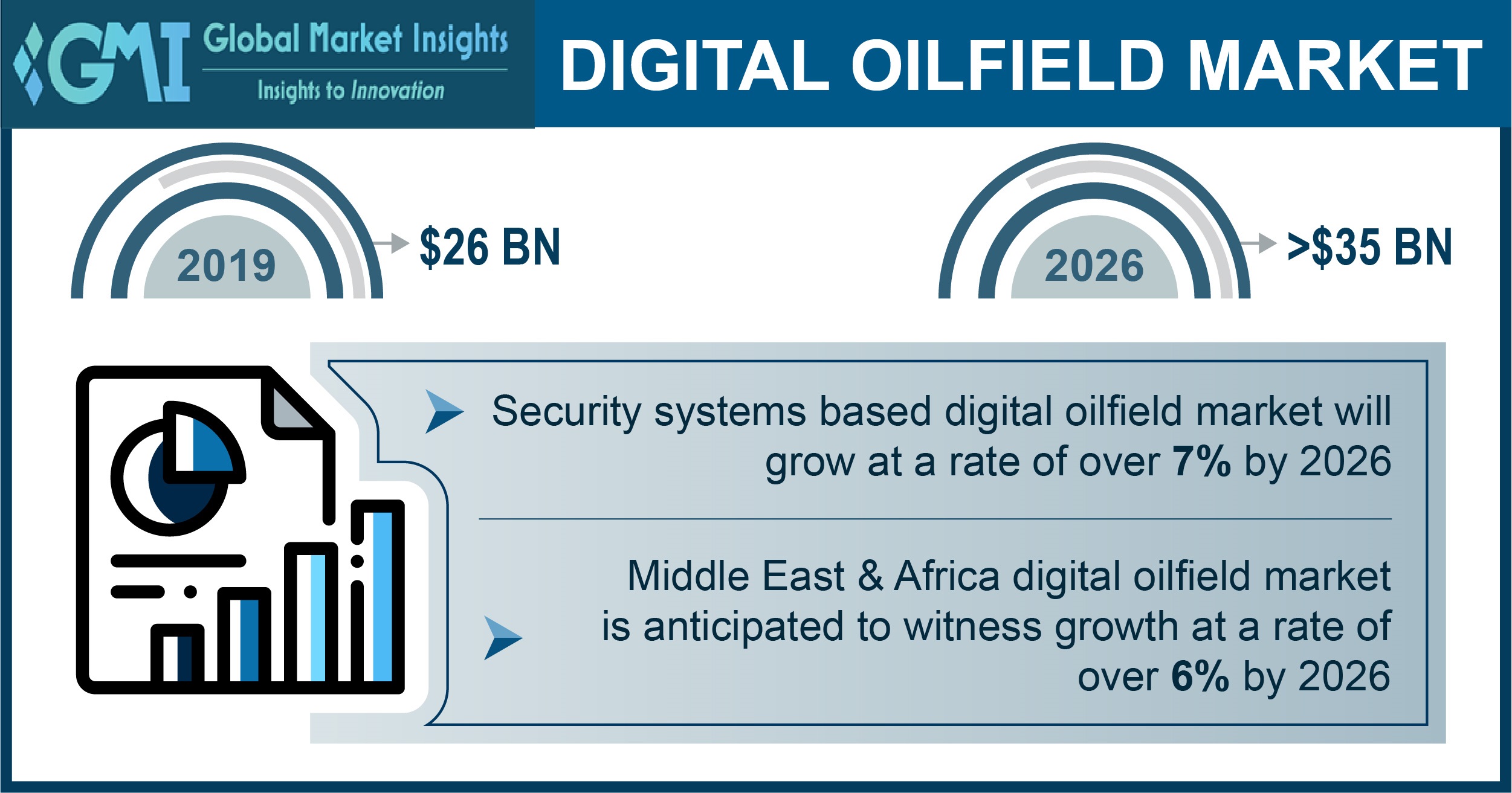Digital oilfields will emerge as a game-changer for the oil & gas industry as it pivots toward remote monitoring and other technologies for more optimized operations.
Technological advancements over the years have given industries worldwide an insight into their operations that were impossible in the past. For the oil and gas industry, these insights can help organizations navigate nearly every aspect of an oil field from discovery to maturity, sustain asset lifespans, and enhance the overall profitability and reliability of their operations.
The emergence of digital oilfields, especially, has become an area of profound evolution over the years, popularized by their ability to merge sophisticated digital technologies with business process management. According to research from Global Market Insights Inc., the digital oilfield market is set to exceed $35 billion by 2026.
Digital oilfield solutions give O&G companies and service providers the tools to monitor and control vital operations at their production plants remotely. These technologies are designed to boost efficiency and productivity in numerous oil & gas applications, including E&P (exploration and production), by mitigating downtime of equipment and improving recovery.
The benefits of digital oilfields are becoming particularly apparent in the wake of the COVID-19 pandemic, which has left many O&G producers scrambling to recover from energy demand shocks arising from the crisis. With industry players vying for more resilience and flexibility across the oil & gas supply chain, digitalization of oil and gas equipment has become a major concern, with technologies like the cloud leading the charge.
Cloud-based digital oilfield technologies pave the way to recovery for major oil & gas organizations
The impact of the coronavirus pandemic was felt across the global economic landscape, with oil & gas being one of the hardest hit industries, especially in terms of labor risks. In July 2021, over 150 workers had to be evacuated from Shell’s North Sea-based Shearwater project, following a viral outbreak that arose at the end of June. To sustain in such situations, several organizations are now working on automating as many operational processes as possible, to prevent such risks in the future.
The adoption of digital oilfield technology is playing a key role in this, noticeably in novel projects aimed at automating critical O&G activities, to mitigate the risk of future labor and operational disruptions. A notable example of this is Halliburton Company’s June 2021 announcement of a contract from KOC (Kuwait Oil Company), for the expansion of the latter’s digital transformation through the deployment of targeted solutions to enhance production and efficiency. By collaborating with KOC, Halliburton was working to expedite their cycle of data-to-decision by automating work processes and implementing digital twins across various KOC assets.
Technologies like the cloud, in particular, are coming to be considered a pillar of digital transformation in oil & gas of late. Whether downstream, upstream, or midstream, certain commonalities are prevalent across the O&G value chain; disparity in ecosystems, disjointed efforts, the existence of unstructured operations, disconnected processes, and significant resource wastage. Streamlining and managing this disjointedness is a major focus area for oil & gas producers, with a shift to cloud computing serving as one of their primary steps toward digital oilfields.
Although O&G firms have historically been slower to adapt to cloud solutions in comparison with other technology-reliant counterparts, a Daily Oil Bulletin study has revealed that almost 40% of industry respondents store their data in the cloud. Recent moves by prominent industry participants corroborate this, by facilitating a seamless shift from in-house storage of data to cloud-based digital oilfield solutions.
For instance, in September 2021, Schlumberger and AVEVA signed an agreement to integrate AI, edge, and cloud solutions for the optimization of oil & gas production, by streamlining the acquisition, processing, and usage of field data by energy operators to improve the performance and efficiency of well sites.
Collaborative efforts will emerge as prominent strategies for digital oilfield market players
Over the years, oil and gas producers, software developers, and oilfield service firms alike are becoming increasingly active in strategic initiatives aimed at powering innovation in the digital oilfield industry. Collaborations are a major part of this move, by helping all involved entities to create tailor-made new digital solutions.
To illustrate, in October 2021, ABB inked an MoU (memorandum of understanding) with Enovate Upstream to use their respective ABB Ability Wellhead Manager and Digital Production technologies for the creation of a completely scalable and automated digital oilfield solution. Using next-gen features like AI (artificial intelligence)-based production technology and a cloud-based platform, the objective behind the alliance was to connect reservoir engineering with operations to maximize asset value and provide deeper insights into real-time production rates.
Similar efforts were also made by Patterson-UTI Energy, which partnered with Corva, to improve visualization capabilities and data analytics to expedite the digital transformation in oil & gas operations. Via the agreement, the companies strived to aid O&G operators in utilizing digital drilling tools and completing more productive and profitable wells, whilst minimizing emissions.
The importance of technology in the digital transformation of the oil and gas industry has grown, positioning digital oilfields as one of the most sought-after solutions in the industry. By investing in the technology, therefore, oil & gas operators will not only have the opportunity to automate and better manage equipment but also power innovation and greener practices in future O&G operations.
